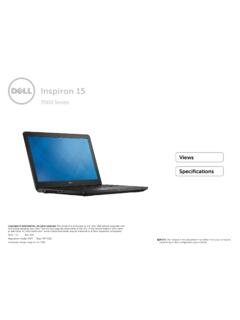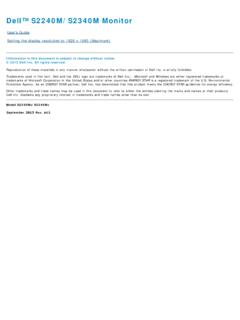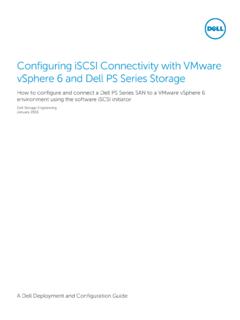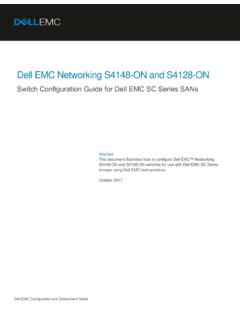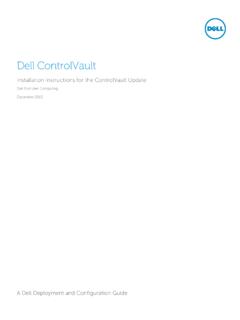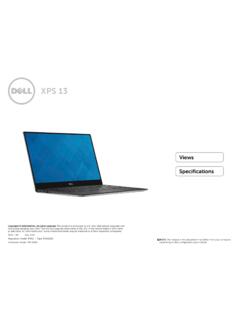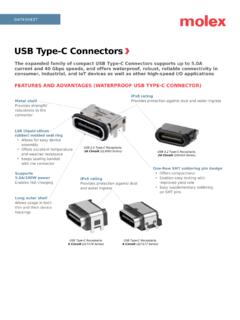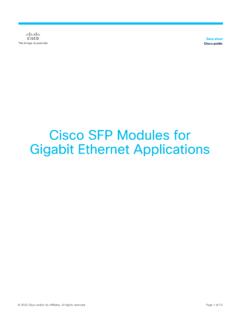Transcription of Dell OptiPlex 9010/7010 Small Form Factor Owner's Manual
1 dell OptiPlex 9010/7010 Small Form FactorOwner's ManualRegulatory Model: D03 SRegulatory Type: D03S002 Notes, cautions, and warningsNOTE: A NOTE indicates important information that helps you make better use of your : A CAUTION indicates either potential damage to hardware or loss of data and tells you how to avoid the : A WARNING indicates a potential for property damage, personal injury, or 2015 dell Inc. All rights reserved. This product is protected by and international copyright and intellectual property laws. dell and the dell logo are trademarks of dell Inc. in the United States and/or other jurisdictions. All other marks and names mentioned herein may be trademarks of their respective 05 Rev. A02 Contents1 Working on Your Working Inside Your Off Your Working Inside Your Removing and Installing the the the Front the Front The Wireless Local Area Network (WLAN) The WLAN the Drive the Drive the Optical the Optical the Hard the Hard the Intrusion the Intrusion The Expansion The Expansion Module the the the Coin-Cell the Coin-Cell the System the System the the the Power-Switch the Power-Switch the Input/Output (I/O) the Input/Output (I/O) the Power the Power the Heat Sink.
2 31 Installing the Heat the the the System Board the System System Setup the BIOS ..49 Jumper and Setup a System Password and Setup or Changing an Existing System and/or Setup a System Pre-Boot System Assessment (ePSA) Troubleshooting Your LED Contacting dell ..6541 Working on Your Computer Before Working Inside Your ComputerUse the following safety guidelines to help protect your computer from potential damage and to help to ensure your personal safety. Unless otherwise noted, each procedure included in this document assumes that the following conditions exist: You have read the safety information that shipped with your computer. A component can be replaced or--if purchased separately--installed by performing the removal procedure in reverse : Disconnect all power sources before opening the computer cover or panels. After you finish working inside the computer, replace all covers, panels, and screws before connecting to the power : Before working inside your computer, read the safety information that shipped with your computer.
3 For additional safety best practices information, see the Regulatory Compliance Homepage at CAUTION: Many repairs may only be done by a certified service technician. You should only perform troubleshooting and simple repairs as authorized in your product documentation, or as directed by the online or telephone service and support team. Damage due to servicing that is not authorized by dell is not covered by your warranty. Read and follow the safety instructions that came with the : To avoid electrostatic discharge, ground yourself by using a wrist grounding strap or by periodically touching an unpainted metal surface, such as a connector on the back of the : Handle components and cards with care. Do not touch the components or contacts on a card. Hold a card by its edges or by its metal mounting bracket. Hold a component such as a processor by its edges, not by its : When you disconnect a cable , pull on its connector or on its pull-tab, not on the cable itself.
4 Some cables have connectors with locking tabs; if you are disconnecting this type of cable , press in on the locking tabs before you disconnect the cable . As you pull connectors apart, keep them evenly aligned to avoid bending any connector pins. Also, before you connect a cable , ensure that both connectors are correctly oriented and : The color of your computer and certain components may appear differently than shown in this avoid damaging your computer, perform the following steps before you begin working inside the that your work surface is flat and clean to prevent the computer cover from being off your computer (see Turning Off Your Computer).CAUTION: To disconnect a network cable , first unplug the cable from your computer and then unplug the cable from the network all network cables from the your computer and all attached devices from their electrical and hold the power button while the computer is unplugged to ground the system the : Before touching anything inside your computer, ground yourself by touching an unpainted metal surface, such as the metal at the back of the computer.
5 While you work, periodically touch an unpainted metal surface to dissipate static electricity, which could harm internal Off Your ComputerCAUTION: To avoid losing data, save and close all open files and exit all open programs before you turn off your down the operating system: In Windows 8: Using a touch-enabled in from the right edge of the screen, opening the Charms menu and select the and then select Shut down Using a to upper-right corner of the screen and click Settings. the and select Shut down. In Windows 7 Shut the arrow in the lower-right corner of the Start menu as shown below, and then click Shut that the computer and all attached devices are turned off. If your computer and attached devices did not automatically turn off when you shut down your operating system, press and hold the power button for about 6 seconds to turn them Working Inside Your ComputerAfter you complete any replacement procedure, ensure you connect any external devices, cards, and cables before turning on your the : To connect a network cable , first plug the cable into the network device and then plug it into the any telephone or network cables to your your computer and all attached devices to their electrical on your required, verify that the computer works correctly by running the dell and Installing ComponentsThis section provides detailed information on how to remove or install the components from your ToolsThe procedures in this document may require the following tools.
6 Small flat-blade screwdriver Phillips screwdriver Small plastic scribeRemoving the the procedures in Before Working Inside Your up the cover-release latch at the side of the the cover upward to a 45 degree angle and remove it from the the the cover on the down on the cover till it clicks into the procedures in After Working Inside Your the Front the procedures in Before Working Inside Your the the front bezel retention clips away from the the bezel away from the computer to release the hooks on the opposite edge of the bezel from the chassis. Then, lift the chassis and remove the front bezel from the the Front the hooks along the bottom edge of the front bezel into the slots on the chassis the bezel toward the computer to engage the front bezel retention clips until they click into the the procedures in After Working Inside Your The Wireless Local Area Network (WLAN) the procedures in Before Working Inside Your the the screws the secure the antenna puck to the connector.
7 Pull out the antenna puck from the the blue tab and lift the latch outwards. Lift and remove the WLAN card from the The WLAN the WLAN card into the connector on the system board and press down until it is securely in place. Fix the the antenna puck on the connector and tighten the screws that secure it to the the the procedures in After Working Inside Your the Drive the procedures in Before Working Inside Your the data cable and power cable from the back of the the drive-cage handle toward the back of the computer into the unlocked the drive cage upward using the handle and lift the drive cage free off the the Drive the drive cage on the edge of the computer to allow access to the cable connectors on the hard the data cable and power cable to the back of the hard over the drive cage and insert it into the chassis. The drive cage tabs are secured by the slots in the the drive-cage handle toward the front of the computer into the locked the data cable and power cable to the back of the optical the procedures in After Working Inside Your the Optical the procedures in Before Working Inside Your the the data cable and power cable from the back of the optical the blue tab and slide the optical drive inwards to remove it from the the sides of the bracket to remove the optical the Optical the optical drive into the the blue tab and slide the optical drive outwards to insert it into the the data cable and power cable to the optical the the procedures in After Working Inside Your the Hard the procedures in Before Working Inside Your the the retention clips inwards and slide the hard-drive bracket out from the drive the hard-drive bracket and then remove the hard drive from the the screws that
8 Secure the hard drive to the top of the hard-drive the screws that secure the hard drive to the underside of the hard-drive the Hard the screws to secure the hard drive to the hard-drive the hard-drive bracket and then insert the hard drive into the the retention clips inwards and slide the hard-drive bracket into the drive the the procedures in After Working Inside Your the Intrusion the procedures in Before Working Inside Your the the intrusion-switch cable from the system the intrusion switch inwards and remove it from the system the Intrusion the intrusion switch into the chassis rear and slide it outward to secure the intrusion-switch cable to the system the the procedures in After Working Inside Your The Expansion the procedures in Before Working Inside Your the release tab on the card-retention latch the release lever away from the expansion card until you release the securing tab from the dent in the card.
9 Then, ease the card up and out of its connector and remove it from the The Expansion the expansion card into the connector on the system board and press down to secure it in the procedures in After Working Inside Your Module GuidelinesTo ensure optimal performance of your computer, observe the following general guidelines when configuring your system memory: Memory modules of different sizes can be mixed (for example, 2 GB and 4 GB). But, all populated channels must have identical configurations. Memory modules must be installed beginning with the first : The memory sockets in your computer may be labeled differently depending on the hardware configuration. For example, A1, A2 or 1,2,3. If the quad-rank memory modules are mixed with single or dual-rank modules, the quad-rank modules must be installed in the sockets with the white release levers. If memory modules with different speeds are installed, they operate at the speed of the slowest installed memory the the procedures in Before Working Inside Your the memory-retention clips on each side of the memory the memory modules out of the connectors on the system the the memory modules into the connectors on the system down on the memory modules until the retention clips spring back to secure them in the procedures in After Working Inside Your the Coin-Cell the procedures in Before Working Inside Your the release latch away from the battery to allow it to pop up from the socket and then lift the coin-cell battery out of the the Coin-Cell the coin-cell battery into its slot on the system the coin-cell battery downward till the release latch springs back into place and secures the procedures in After Working Inside Your the System the procedures in Before Working Inside Your the fan cable from the system
10 The cable from the and remove the system fan away from the grommets securing it to the computer. Then, press the grommets inward along the slots and pass through the the System the system fan in the the grommets through the chassis and slide outward along the grooves to secure them in the fan cable through the restraint and connect it to the system the procedures in After Working Inside Your the the procedures in Before Working Inside Your the speaker cable from the system the speaker-securing tab, and slide the speaker towards the right of the computer to release the the speaker at the appropriate location on the chassis the speaker-securing tab and slide the speaker towards the left of the computer to secure the speaker cable to the system the procedures in After Working Inside Your the Power-Switch the procedures in Before Working Inside Your the power-switch cable from the system in the retention clips and slide the power-switch cable out through the front of the the Power-Switch the power-switch cable in through the front of the the power-switch cable to the the power-switch cable into the chassis the power-switch cable to the system the procedures in After Working Inside Your the Input/Output (I/O)
